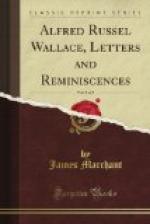My dear Poulton,—I have read your paper on “Theories of Evolution"[26] with great pleasure. It is very clear and very forcible, and I should think must have opened the eyes of some of your hearers. Your cases against Lamarckism were very strong, and I think quite conclusive. There is one, however, which seems to me weak—that about the claws of lobsters and the tails of lizards moving and acting when detached from the body. It may be argued, fairly, that this is only an incidental result of the extreme muscular irritability and contractibility of the organs, which might have been caused on Lamarckian as well as on the Darwinian hypothesis. The running of a fowl after its head is chopped off is an example of the same kind of thing, and this is certainly not useful. The detachment itself of claw and tail is no doubt useful and adaptive.
When discussing the objection as to failures not being found fossil, there are two additional arguments to those you adduce: (1) Every failure has been, first, a success, or it could not have come into existence (as a species); and (2) the hosts of huge and very specialised animals everywhere recently extinct are clearly failures. They were successes as long as the struggle was with animal competitors only, physical conditions being highly favourable. But, when physical conditions became adverse, as by drought, cold, etc., they failed and became extinct. The entrance of new enemies from another area might equally render them failures. As to your question about myself and Darwin, I had met him once only for a few minutes at the British Museum before I went to the East.... —Yours very faithfully,
A.R. WALLACE.
* * * * *
TO MR. CLEMENT REID
Parkstone, Dorset. November 18, 1894.
My dear Clement Reid,— ... The great, the grand, and long-expected, the prophesied discovery has at last been made—Miocene or Old Pliocene Man in India!!! Good worked flints found in situ by the palaeontologist to the Geological Survey of India! It is in a ferruginous conglomerate lying beneath 4,000 feet of Pliocene strata and containing hippotherium, etc. But perhaps you have seen the article in Natural Science describing it, by Rupert Jones, who, very properly, accepts it! Of course we want the bones, but we have got the flints, and they may follow. Hurrah for the missing link! Excuse more.—Yours very faithfully,
ALFRED R. WALLACE.
* * * * *
The next letter relates to the rising school of biologists who, in opposition to Darwin’s views, held that species might arise by what was at the time termed “discontinuous variation.”
TO PROF. MELDOLA
February 4, 1895.
My dear Professor Meldola,—I hope to have copies of my “Evolution” article in a few days, and will send you a couple. The article was in print last September, but, being long, was crowded out month after month, and only now got in by being cut in two. I think I have demolished “discontinuous variation” as having any but the most subordinate part in evolution of species.




